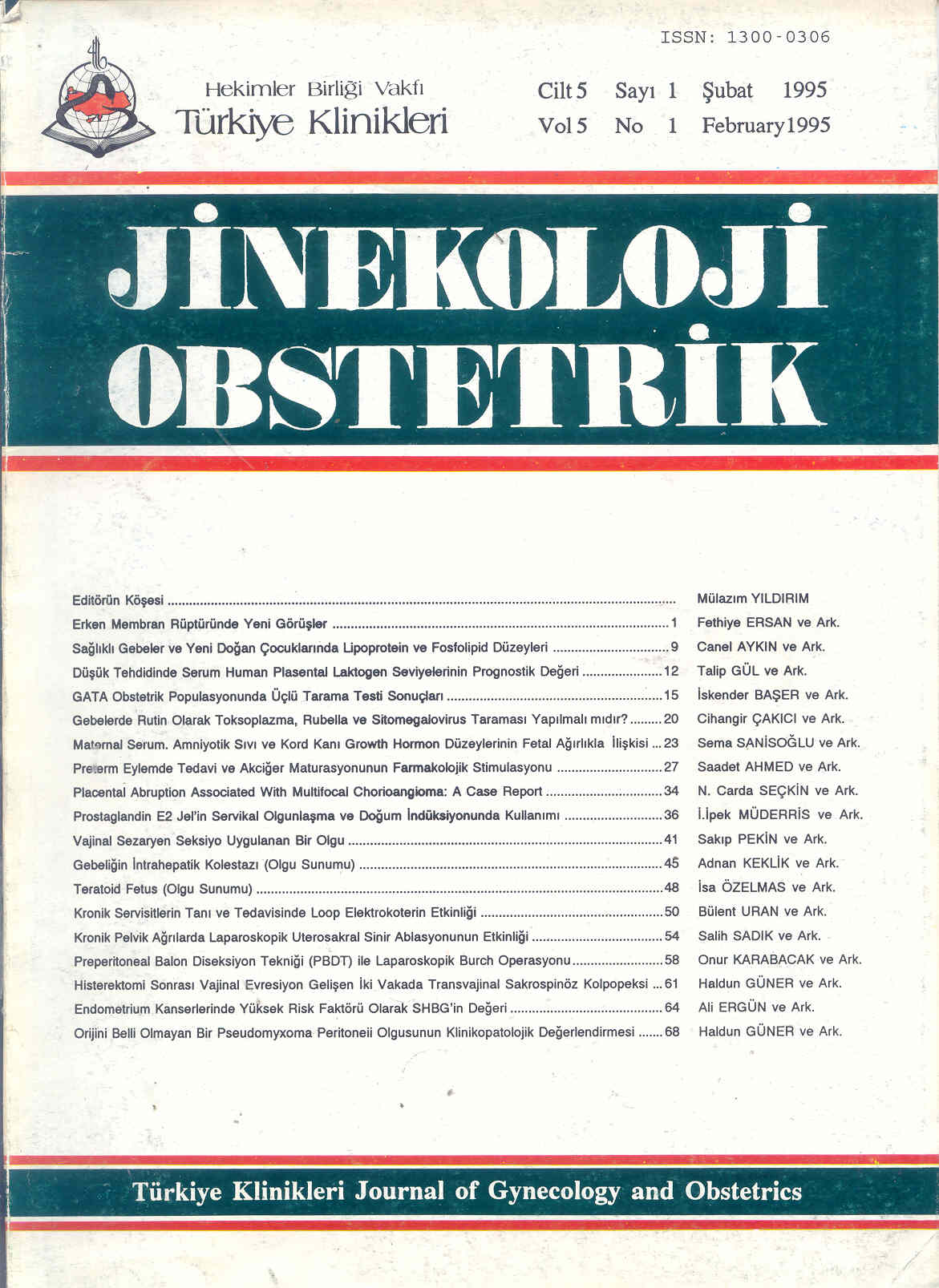Open Access
Peer Reviewed
ARTICLES
3622 Viewed1194 Downloaded
The Prognostic Value Of Human Plasental Lactogen Levels In Threatened Abortion
Düşük Tehdidinde Serum Human Plasental Laktogen Seviyelerinin Prognostik Değeri
Turkiye Klinikleri J Gynecol Obst. 1995;5(1):12-4
Article Language: TR
Copyright Ⓒ 2025 by Türkiye Klinikleri. This is an open access article under the CC BY-NC-ND license (http://creativecommons.org/licenses/by-nc-nd/4.0/)
ÖZET
Amaç: Bu çalışmada maternal serum plasental lactogen (HPL) düzeylerinin düşük tehdidindeki önemini değerlendirmek amaçlandı. Çalışmanın Yapıldığı Yer: Dicle Üniversitesi Tıp Fakültesi Kadın Hastalıkları ve Doğum AD ile Nükleer Tıp AD. Gereç ve Yöntemler: Gebelik yaşları 6-12 hafta arasında değişen 50 abortus imminensli (grup II) ve 50 sağlıklı gebede (grup I) maternal serum HPL düzeyleri ölçüldü ve sonuçlar karışılaştırıldı. Çalışma grubundaki olgular; gebeliği devam eden olgular grup IIa ve gebeliği abortusla sonuçlanan olgular grub IIb olmak üzere iki alt gruba ayrıldı. Grup I olguların hiçbirisinde abortus tespit edilmedi. Ayrıca bu gruplardaki HPL düzeylerinin istatistiksel önemi değerlendirildi. Bulgular: Abortus imminens grubundaki ortalama serum HPL değerleri, sorunsuz gebelerdeki HPL değerlerinden anlamlı olarak daha düşük bulundu (p< 0.001). Sonuç: Maternal serum HPL değerlerinin, abortus imminensin ve istenmeyen gebelik sonuçlarının erken tanısında önemli bir biyokimyasal indikatör olabileceği sonucuna varıldı.
Amaç: Bu çalışmada maternal serum plasental lactogen (HPL) düzeylerinin düşük tehdidindeki önemini değerlendirmek amaçlandı. Çalışmanın Yapıldığı Yer: Dicle Üniversitesi Tıp Fakültesi Kadın Hastalıkları ve Doğum AD ile Nükleer Tıp AD. Gereç ve Yöntemler: Gebelik yaşları 6-12 hafta arasında değişen 50 abortus imminensli (grup II) ve 50 sağlıklı gebede (grup I) maternal serum HPL düzeyleri ölçüldü ve sonuçlar karışılaştırıldı. Çalışma grubundaki olgular; gebeliği devam eden olgular grup IIa ve gebeliği abortusla sonuçlanan olgular grub IIb olmak üzere iki alt gruba ayrıldı. Grup I olguların hiçbirisinde abortus tespit edilmedi. Ayrıca bu gruplardaki HPL düzeylerinin istatistiksel önemi değerlendirildi. Bulgular: Abortus imminens grubundaki ortalama serum HPL değerleri, sorunsuz gebelerdeki HPL değerlerinden anlamlı olarak daha düşük bulundu (p< 0.001). Sonuç: Maternal serum HPL değerlerinin, abortus imminensin ve istenmeyen gebelik sonuçlarının erken tanısında önemli bir biyokimyasal indikatör olabileceği sonucuna varıldı.
ANAHTAR KELİMELER: Abortus imminens, human plasental lactogen
ABSTRACT
Objective: The aim of this study was to evaluate the significance of the maternal serum human placental lactogen (HPL) levels in abortus imminence. Intitutions: Department of Obstetrics and Gynecology, and Department of Nuclear Medicine, Faculty of Medicine, Dicle University. Material and Methods: The maternal serum HPL levels have been measured in 50 abortus imminence (grup II) cases, 6-12 weeks gestational age, and the values were compared to those obtained in 50 healthy pregnancies (grup I). At the age of 20 weeks all cases were assesed for the abortion rate. The group II was than divided into two subgroups; group IIa continuing pregnancies, and grub IIb aborted pregnancies. No abortion has been detected in group I. Furthermore statistical significance of HPL levels in theses groups have been evaluated. Results: The mean serum HPL values in group I (abortus imminence) were significantly (p< 0.001) lower than those found in uneventfull pregnancies (group I). Conclusion: It is concluded that the maternal HPL levels can be a significant biochemical indicator in early diagnosis of abortus imminence and the adverse pregnancy outcome.
Objective: The aim of this study was to evaluate the significance of the maternal serum human placental lactogen (HPL) levels in abortus imminence. Intitutions: Department of Obstetrics and Gynecology, and Department of Nuclear Medicine, Faculty of Medicine, Dicle University. Material and Methods: The maternal serum HPL levels have been measured in 50 abortus imminence (grup II) cases, 6-12 weeks gestational age, and the values were compared to those obtained in 50 healthy pregnancies (grup I). At the age of 20 weeks all cases were assesed for the abortion rate. The group II was than divided into two subgroups; group IIa continuing pregnancies, and grub IIb aborted pregnancies. No abortion has been detected in group I. Furthermore statistical significance of HPL levels in theses groups have been evaluated. Results: The mean serum HPL values in group I (abortus imminence) were significantly (p< 0.001) lower than those found in uneventfull pregnancies (group I). Conclusion: It is concluded that the maternal HPL levels can be a significant biochemical indicator in early diagnosis of abortus imminence and the adverse pregnancy outcome.
MENU
POPULAR ARTICLES
MOST DOWNLOADED ARTICLES





This journal is licensed under a Creative Commons Attribution-NonCommercial-NoDerivatives 4.0 International License.










